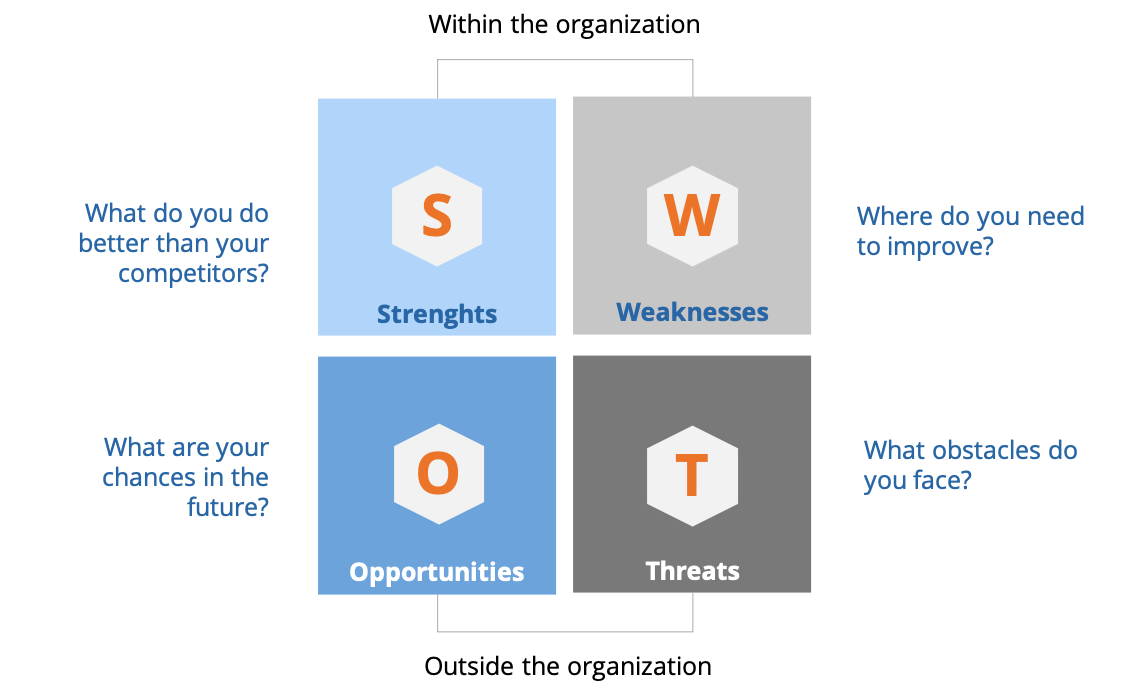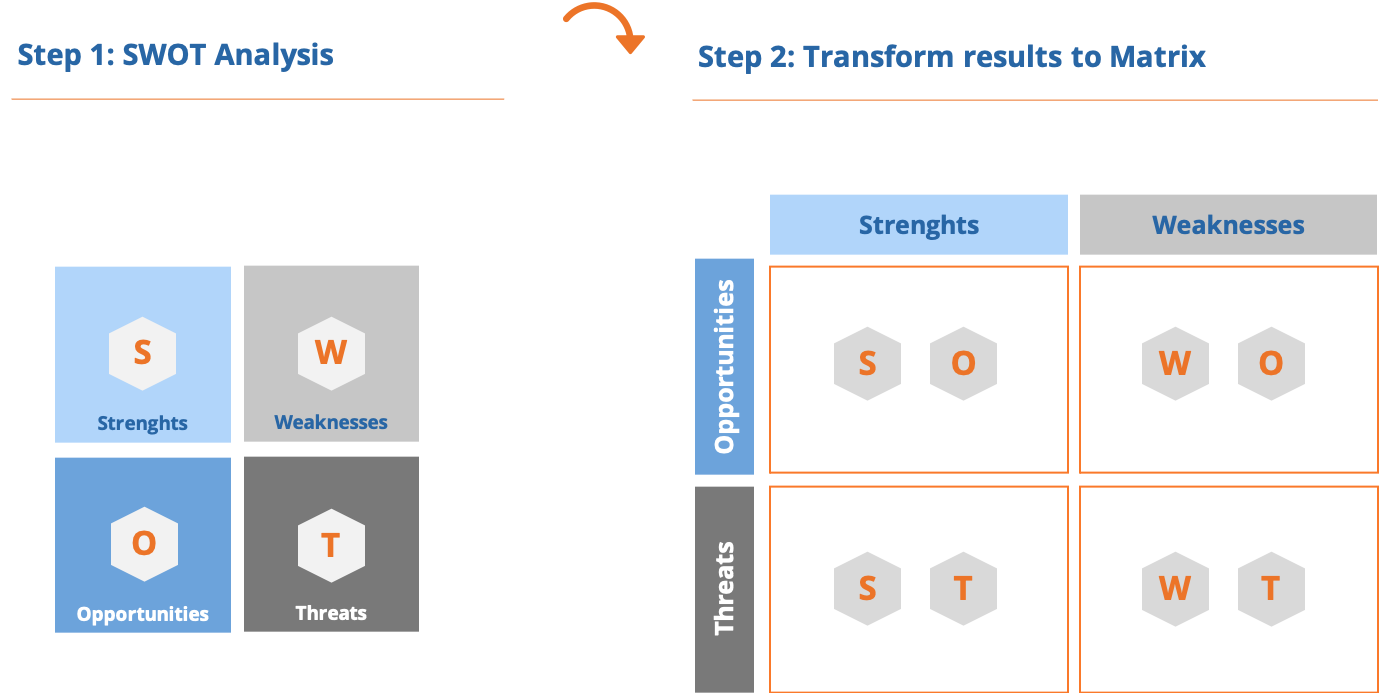Do you know the 5 most common mistakes in a SWOT analysis?
SWOT is the abbreviation for Strength, Weakness, Opportunities and Threats. In German: strengths, weaknesses, opportunities and threats. It is one of the best-known and most frequently used management methods. Its strength lies in its simple application for many topics in the company. A simple 4-field matrix represents the grid for the SWOT analysis. Despite this simple application, errors can creep into the application. You should know and avoid these. Only then does the SWOT analysis unfold its huge potential in everyday business life.
The SWOT analysis and its importance
The SWOT analysis was developed in the 1960s at Harvard Business School for use in companies.
Even today, the SWOT analysis is one of the best-known and most frequently used methods in the context of strategic planning. The abbreviation SWOT stands for Strengths, Weaknesses, Opportunities and Threats.
With the help of the SWOT analysis, strengths and weaknesses of a company, a department, of processes or of products and services can be found out. This corresponds to an internal company analysis. The method also compares the opportunities and risks in relation to the environment and the competition ( see also the definition of a SWOT analysis ). At the same time, it covers an external environmental or environment analysis. Both analysis types are mapped in a 2×2 matrix. See also the figure below:

The classic SWOT analysis
Incorrect application of the SWOT analysis
In the end, the success of a management method is measured by concrete and goal-oriented measures. In contrast, the SWOT analysis first of all describes conditions inside and outside the company. The success of a SWOT analysis can only be seen in the consequences and strategies derived from it, or their implementation. See also our article ” Successful specification of a strategy “.
When using the actual SWOT analysis, you often come across the following 5 errors:
- Lack of comparison with the competition
- Unstructured derivation of consequences
- Unilateral focus during analysis
- Lack of topic and goal orientation
- Incorrect order of application
In the following, we will go into more detail about these errors and show how they can be prevented.
Lack of comparison with the competition
When analyzing strengths and weaknesses, this should always be done in direct comparison with the competition. A strength or a weakness that also applies to all competitors at the same time can be neglected. The easiest way to proceed is to ask yourself the question: “What are the concrete strengths or weaknesses compared to the 3 main competitors?”. Make sure that not only direct competitors are considered, but also potential new market entry candidates are relevant. For example, an insurance company should not only keep an eye on its direct competitors, but also on platform providers such as Amazon, Alibaba, etc. These have already proven several times that they can expand their market power to related company fields (example: Amazon discovers the insurance business of n-tv, 2021).
Unstructured derivation of consequences
As mentioned, the analysis results of the four SWOT fields only describe a state. For successful management, the derived consequences are now decisive. Avoid the mistake of only looking at the weaknesses one-sidedly or using the opportunities immediately as a strategic guideline. In practice, a structured approach called the TOWS matrix has proven to be advantageous here (see also the TOWS method description ).
The TOWS Matrix is based on a classic SWOT analysis. The results of the company’s strengths and weaknesses and the resulting opportunities and risks are compared in a matrix. Each combination of SWOT fields results in a specific strategic thrust:
- S trengths & Opportunities result in measures aimed at maximum success .
- W eaknesses & Opportunities lead to activities that make it possible to catch up with the competition .
- S trengths & Threats lead to actions to defend the achieved success .
- W eaknesses & Threats derive actions to secure existence .

From the SWOT analysis to the TOWS matrix
Unilateral focus during analysis
Distortions in the analysis often occur, especially when a well-trained team or department gets together to carry out a SWOT analysis. In doing so, individual fields of the SWOT matrix are focused one-sidedly by basking in the strengths or, in the case of weaknesses, by targeting those that come from others. Again and again one finds that a previously formulated hypothesis should be supported by the results of the analysis. The view of strengths, weaknesses, opportunities and risks is therefore perceived to be very limited.
This distortion of results can also creep in if superiors with strong opinions or patriarchal managers are actively involved in the elaboration. The participants then often orientate themselves on their statements in order to avoid any contradictions or resentment.
How can this be prevented?
The group of participants should be as heterogeneous as possible. So they come from different areas and/or belong to different hierarchies. Women and men should also deliberately participate in the analysis together, since their perspectives on things can be different. It often also helps when outsiders such as consultants or suppliers who are able to express independent opinions are involved. Even an independent and anonymous implementation of the SWOT analysis, as made possible by the digital consulting platform from ConWISE, leads to open and unbiased results.
Lack of topic and goal orientation
“Let’s do a quick SWOT analysis!” Managers can be heard shouting. And the flipchart or whiteboard is divided into a 4-field matrix and off you go. Then a confused collection of points takes place. Although a lot of content comes together, the consequences derived from it are not satisfactory in the long term. The problem with this is that the measures follow no recognizable direction. This can be prevented by narrowing down the subject area for the SWOT analysis at the beginning and writing it down. The topic must always be visible or visible to every participant.
The topic can include a specific product, service or process. Make sure that the description is as specific as possible. Example: instead of “SWOT analysis in the service area”, it should read “SWOT analysis for the introduction of a new service in the after-sales area”.
The specific naming of the topic or goal also helps you to carry out the environment analysis, i.e. to record the opportunities and risks. This is because the influencing factors to be considered can be almost infinite. There is a multitude of political, economic, social and technological developments. The solution is simple: focus on the influences that are gaining in importance because of the named topic/goal.
Incorrect order of application
We recommend that you start with the internal analysis – the company – and thus go into the strengths and weaknesses first. These can usually be formulated and described very specifically. You get fast results in the analysis and are then motivated to dedicate yourself to the external analysis – the environment. It also helps you to limit the external influencing factors if necessary, in that the strengths and weaknesses that have already been recorded serve as a guide.
In the area of chances (opportunities), these are often described as concrete options for action. However, this derivation of strategic options should only take place in the next step of the SWOT analysis. During the analysis, the observations of the environment are in the foreground. Example: “Participation in a startup to develop a new AI application” (specific option for action) versus “Many new startups in the field of AI” (general description of the market environment with potential opportunities).
In a broader sense, an incorrect order of application can also apply to the timing of the SWOT analysis. This should always serve as a starting point for an actual strategy development and not vice versa. Otherwise, the analysis would take on an alibi role in order to legitimize a predetermined strategic direction. This also applies to activities that have already been carried out and whose justification is only provided by a subsequent SWOT analysis.
Conclusion
Although the SWOT analysis has been used in almost every company worldwide for decades, errors can still creep in today. At first glance, this is often not even recognizable, because the SWOT analysis usually brings up a large number of points. In terms of quantity, the management and the participants can usually be very satisfied. Mistakes in the application of methods are noticeable: when it comes to the qualitative implementation of the findings. The results fall short of expectations. This becomes particularly clear when the results are re-evaluated after some time has passed.
If those responsible and initiators of the analysis know the errors shown here and avoid them accordingly, the SWOT analysis is and remains one of the most effective tools in strategic planning. A simple way of preventing the errors listed from creeping in in the first place is to use the respective SWOT and TOWS frameworks on ConWISE’s digital consulting platform.
The ConWISE team will be happy to show you exactly how this works during a non-binding appointment. Contact us!










